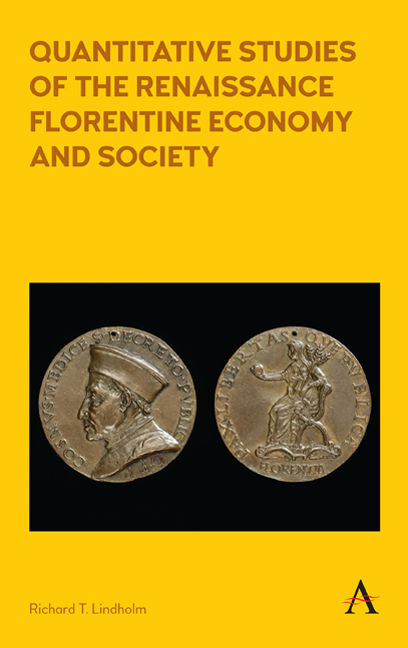Book contents
- Frontmatter
- Dedication
- Contents
- List of Illustrations
- Preface
- Acknowledgments
- List of Abbreviations
- Introduction
- Part I RISKS AND RETURNS
- Chapter One The Costs and Benefits of Running Away: Late Medieval Florentine Plague Mortality and Behavior
- Chapter Two When Economic Theory Meets Medieval Contracts: Calculating the Monte Comune Interest Rate
- Part II SOCIETY
- Part III WORK
- Conclusion
- Glossary
- Bibliography
- Index
Chapter One - The Costs and Benefits of Running Away: Late Medieval Florentine Plague Mortality and Behavior
from Part I - RISKS AND RETURNS
Published online by Cambridge University Press: 10 January 2018
- Frontmatter
- Dedication
- Contents
- List of Illustrations
- Preface
- Acknowledgments
- List of Abbreviations
- Introduction
- Part I RISKS AND RETURNS
- Chapter One The Costs and Benefits of Running Away: Late Medieval Florentine Plague Mortality and Behavior
- Chapter Two When Economic Theory Meets Medieval Contracts: Calculating the Monte Comune Interest Rate
- Part II SOCIETY
- Part III WORK
- Conclusion
- Glossary
- Bibliography
- Index
Summary
Introduction
The Black Death that ravaged Europe and arrived in Florence, Italy, in 1348 is one of the best-known events in the history of medieval Europe. It is widely considered a transformational event that produced fundamental changes in both the economy and the society. However, there is more to the story. That plague was only the first in a long series that periodically revisited Europe for centuries. Plague outbreaks became a fundamental characteristic of the society. In the case of Florence during the following century alone the plague returned 11 times: 4 times later in the Trecento and 7 times during the first half of the Quattrocento. It returned as late as the seventeenth century. Despite its importance, critical aspects of the disease are unknown and have been debated for decades among medical and social historians. The plague's societal impact is also unclear. For example, its impact on certain segments of society, such as the poor or children, and whether it led to greater social controls are all open questions.
These repeated outbreaks allow a researcher to assemble multiple observations of the same phenomenon and to better test his or her theories. The plague's seasonal pattern provides clues to its nature because changing temperature and humidity affect the disease's transmission vectors. Although historians using the available aggregate death data have found a summertime peak in deaths, the implications of these findings would exclude bubonic plague, Yersinia pestis, the most likely cause identified by medical researchers. To date, researchers have concentrated on medical data or demographic records in trying to understand the disease. The study presented in this chapter uses a very different source of quantitative behavioral data—the Florentine currency exchange market—to analyze the seasonality of plague virulence. Although the market is an indirect source, it provides daily updates of actual behavior during a given plague and in the periods before and after that plague. The market data imply that flight from the plague was significant and that people sometimes stayed away from the city of Florence for long periods of time. This implies that the plague was not exclusively a summertime phenomenon and explains both the evolution in total deaths across plagues and the differences in the timing of deaths between major and minor plagues.
- Type
- Chapter
- Information
- Publisher: Anthem PressPrint publication year: 2017



